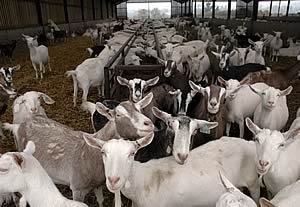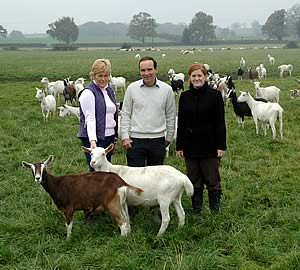| |
|
18/11/08
The diminutive UK commercial dairy goat sector offers an opportunity for some conventional dairy farmers to consider exploiting, however they should progress with caution, according to the Royal Association of British Dairy Farmers.
Milking goats
 |
“The dairy goat product sector has expanded by approximately 20% year on year in the decade to 2006/07, until last year when that figure fell to 16%,” RABDF’s Laura Dickinson told a briefing at Stafford today, Thursday 6 November. “That overall trend has been driven by consumers becoming increasingly aware of the health benefits of dairy goats’ milk, including its ease of digestibility and lower natural cholesterol levels,” she said. “However goats’ milk accommodates just 0.1% of the UK milk market and the combined value of milk plus product is currently worth £50m per annum.”
The UK produces an annual 22 million litres of milk, while it imports, mainly from the Netherlands 65% of the total 50 million litres of milk required each year for liquid, cheese and other products.
As few as 45 herds in the UK are contributing to the 22 million litre annual pool. Herd size varies from 250 to 4,000 milking goats, while the average herd figure amounts to 900 head. Average yield stands at 900 litres per lactation and a lifetime expectancy of six lactations.
Goats’ milk in the UK is traded and processed by five main companies. Farm gate price is fixed by each individual company, she explained. “While each individual processor carries out its own respective marketing campaigns, they are admittedly extremely limited due to scale of operations. In addition, there is no collection mechanism in place for a farmer levy. In the last 12 months for example, money spent on advertising and PR for goats’ milk has been relatively small. Compare this with Arla’s Cravendale brand which plans to spend £10m on reinforcing their brand messages in the next 12 months.”
Miss Dickinson emphasised that commercial goat farming was very much in its infancy in the UK. “As far as genetics are concerned, few if any dairy goats worldwide have been progeny tested, consequently a minimal amount of AI is practiced. However, it is believed that there are real opportunities to exploit the current genetics farmed in the UK Saanen, Toggenburg, Nubian and Alpine by developing and feeding more finely tuned diets and exploring different management options.
As far as returns are concerned, then establishing a new dairy goat enterprise does stack up, she said. “Return on investment is significantly greater compared with a conventional dairy cow enterprise which requires a considerably higher investment to meet with various compliance requirements including the challenges of the NVZ Action Programme.” See table 1.
Table 1: Enterprise set up costs: dairy cows vs dairy goats
| |
Dairy cows |
Dairy goats |
Stocking on 200 acres |
100 cows |
1,500 goats |
Entry cost / head (£) |
5,000 |
600 |
Herd annual turnover (£) |
200,000 + |
575,000 |
Source: Graeme Surtees, Nov 08
“However, swapping dairy cows for dairy goats is far, far less attractive than it was say five years ago when farmgate dairy goats’ milk averaged 40ppl compared with dairy cow milk averaging 17ppl. But the investment costs remain lower, for example a milking goat from a high health status herd costs approximately £250 and parlour modification can costs in the region of £40,000. Furthermore, dairy cow farmers have the basic requirements of some accommodation and a parlour which can be readily modified.
“So why aren’t we witnessing more dairy cow farmers taking that leap of faith and moving over the fence? The industry believes that UK dairy farmers and their tendency towards conservatism poses a real psychological barrier, together with the real lack of technical expertise, never mind any funded research or development.
“Basically dairy goat farming has yet to be accepted as a real commercial enterprise offering business growth and development opportunities. However it maybe possible to be a big fish in a very small pond, and help to drive forward a sector on the cusp of further development.”
Case study
Caroline and Nick Brandon with right, RABDF’s Laura Dickinson
 |
Nick Brandon has gradually swapped a 170 cow pedigree Holstein herd for 1,600 milking goats, an enterprise that is scheduled for further expansion to 2,000 head by 2009. “We introduced goats back in 1997 as an additional enterprise thinking the two, cows and goats could run along side each other, however, the workload dictated it impractical.
“It was back in the days when clean quota was valued at 10ppl, farmgate milk price was totally unsustainable at an average 17ppl and there were no long term prospects in conventional dairy farming,” explained Nick who farms in partnership with his wife, Caroline, Upper Enson Farm, a 400 acres owner occupied unit at Sandon, Stafford.
“While the goats were more demanding, we were encouraged by the trends for goat milk and the price was more attractive. The sector also provided us with an opportunity to move closer to the marketplace and for example discuss with our processor its proposed new product launches. So we took the decision in 2005 to sell the cows and establish an efficiently run goat enterprise.”
Since then milking goat numbers have gradually increased, existing accommodation modified and an 88 point internal rotary parlour installed, the largest in the UK. The herd is currently averaging 800 litres per 48 week lactation, a gross margin of £136 a head and £680 per acre. All milk is sold on contract to Delamere Dairy for a current 42.24ppl.
“Knowing everything we know now would we do it all again? We are on a journey and we feel we are very much pioneering the way,” he said. “This is a very long term project and it will take a few years before we have achieved a fair return on capital investment. For starters we need to achieve our immediate targets, to expand the herd to 2,000 milkers by 2009, and improve our herd genetics, nutrition and management in order to increase yield to an average 1,000 litres, gross margin per head to £200 and gross margin per acre to £1,000.
“However unlike the highly technical dairy cow sector, there have been very, very few developments in commercial dairy goat farming; it’s all about self help and learning from other farmers. For example, this summer, I was the first in the UK to graze a portion my milking herd in a paddock system and I’ve introduced a nutritionist in an attempt to formulate more finely tuned diets to exploit yield. Sourcing volumes of milking goats from high health status herds in the UK remains pot luck; I’ve just started doing AI, we plan to import semen from France the only country with improved progeny, and eventually breed our own billy stud.”
To those farmers considering quitting dairy cows for goats, Mr Brandon says, ‘think again’. “If you’re not already making money from your cows, then introducing a herd of milking goats is not the road to riches. For starters you need at least a spare £0.5m capital for investment in goats and equipment, and you must be aware you’ll be making a huge leap into the dark.
“Furthermore the commercial dairy goat industry, like the conventional dairy cow sector has it’s own set of challenges and issues,” he said adding: “I believe for our sector to move forward, then it needs to introduce some transparency in its milk pricing, for example introducing a processor league table. We also need some stability and the opportunity to help towards price making would be welcome.”
• RABDF is fully aware of the fact the UK commercial dairy goat sector remains relatively under developed in terms of technical research and development and subsequent available information, together with market intelligence. Following on from the success of the Association’s inaugural open day for commercial producers 12 months ago, RABDF is staging a similar event at Upper Enson Farm, Sandon, Stafford on Wednesday 26 November. The day is designed to provide all visitors will the opportunity to discuss specific issues relating to commercial goat production to help them gain a better understanding of the dairy and meat market, health issues, AI and nutrition.
 NMR Text Brings Milk Results to Attention NMR Text Brings Milk Results to Attention
 World First at Borderway Black and White Sale World First at Borderway Black and White Sale
 NMR Strenghtens Northern Ireland Team NMR Strenghtens Northern Ireland Team
|




